Author Archive
Let me explain to you why I don’t care for Basement Jaxx
October 28, 2009Honestly I don’t feel very strongly about Basement Jaxx in either direction. But lately I’ve been listening to “Where’s Your Head At” a bunch. It’s a very good song, mostly thanks to the firepower of its fully armed and operational Gary Numan sample. But it’s as though they were unsatisfied with merely centering their song around one of the most monstrous synth lines ever constructed and felt compelled to add a bunch of unnecessary junk to it, like some kind of obsessive-compulsive disorder. The single edit in the video above is better than the full-length version in this regard, but it still gets a little too goofy with the funny voices. And the full-length version has about 45 unnecessary seconds in the middle and another 45 unnecessary seconds at the end. It’s not like I’ve listened to a ton of Basement Jaxx, but pretty much everything I’ve heard is like this in some way–just too busy. I understand that this is considered “maximalism,” but for me it’s clutter, or mania, or trying too hard, or something else unappealing, and when you’ve divorced it from a colossal Numanism it’s not something I’m interested in hearing at all.
Comics Time: Dark Reign: The List #7–Wolverine
October 28, 2009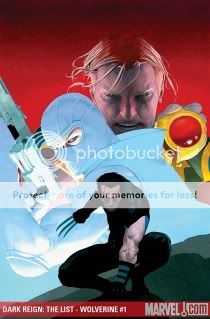
Dark Reign: The List #7–Wolverine
Jason Aaron, writer
Esad Ribic, artist
Marvel, October 2009
48 pages
$3.99
Well well well, looks like Marvel decided maybe they should have strained that Grant Morrison bathwater for babies before they threw it all out. Yeah, Joss Whedon (and, in those nobly intentioned but ill-conceived Phoenix minis, Greg Pak) got to nod in New X-Men‘s direction now and then–Cassandra Nova, a one-line reference to Magneto’s trashing of Manhattan, even the Bug Room. But other than wiping out Genosha, killing Jean Grey, and establishing Emma Frost as the X-Men’s new HBIC, Marvel basically ran, not walked, away from Morrison’s ideas and tone alike. (Exhibit A: that Xorn arc from New Avengers.) So writer Jason Aaron’s full-fledged Morrison Marvel Team-Up in this very very central event title, pitting Wolverine, Marvel Boy (!), and Fantomex (!!!) against Norman Osborn for the fate of The World (i.e. the Morrison-created birthplace of the Weapon Plus program that spawned everyone from Captain America to the ol’ Canucklehead), is something of a turning point. Certainly I didn’t expect to see a French-accented international man of mystery playing a role in Dark Reign, except perhaps as someone for Ares to chop in half in a throwaway sequence in Dark Avengers.
What’s impressive about this is that rather than try to ape high Morrisonian “mad ideas” (except for a played-for-laughs viral-religion thing), Aaron riffs on an entirely different Morrison tone: cheeky high-concept comedy. Instead of writing Marvel Boy as some sort of brooding military brat, Aaron returns him to the quasi-Clockwork Orange blend of arrogance, ultraviolence, and killer good looks that made his original Morrison miniseries such a hoot. He’s like Chuck Bass with insect DNA. (Okay, more insect DNA.) Similarly, Fantomex is treated as a charming rogue with a cool white uniform rather than Aaron simply waving his hands in the face of his weird power set and Frenchness and giving up or phoning in some black-ops boilerplate. Wolverine actually plays a supporting role more than anything else, but when he’s unleashed, it’s in a splatstick fashion consistent with the joli-laid physicality Morrison’s collaborator Frank Quitely imbued him with. Ribic’s art goes a long way in this regard–I’d previously known him only for his admittedly dynamic Alex Ross-indebted painted work, but his pencils have a cartoony zest that would be right at home on some three-issue Vertigo miniseries.
What does it all mean in the context of Dark Reign and The List and so on? As best I can tell, not much. But reintegrating Morrison’s many toys into the mainstream Marvel Universe, as opposed to the province of editorially hands-off limited series, is pretty momentous in and of itself. Fingers crossed we’ll see the Phoenix Corps again when all is said and done.
Carnival of souls
October 27, 2009* Today’s Strange Tales Spotlight subject is Chris Chua, a relative unknown who more than anyone else in the series so far is gonna make you marvel that this is being published by Marvel.
* Whoa, The Comics Journal is shifting to a semiannual with a beefed-up online component.
* Battlestar Galactica: The Plan comes out on DVD today, and thus ends the series. It turns out I don’t enjoy this sort of release pattern at all–instead of making this appointment television, it’s become “eh, I’ll buy it eventually.”
* Oh yeah, buncha Monty Python docs of the sort I usually really enjoy come out today too.
* Given my usual preoccupations in terms of this show it’s probably no surprise that my favorite parts of Whitney Matheson’s reader Q&A with Lost honcho Damon Lindelof center on how outside concerns like actor availability and budget overruns affected Lost‘s story.
* The Hellraiser remake is going to be 3-D, I guess.
* New Chris Ware! (Via JK Parkin.)

* Honestly, my main takeaway from these interview snippets with Marvel VP of Sales David Gabriel is that Marvel will be switching to a more DC-style release pattern with its trade paperbacks–i.e. they’ll take forever to come out–which really bums me out as someone who really only ever wants or buys trade paperbacks for this material. I imagine the reasoning behind not wanting to stagger the release of books featuring the same character will raise some eyebrows.
* Jason Adams is on the Scott Pilgrim movie beat, catching some interesting tweets from Juno director Jason Reitman following a screening of 30 minutes of footage from Edgar Wright’s adaptation:
It is a game changer for Edgar and the genre. It moves the speed of light and carries more unadulterated joy than Ive seen in recent cinema.
SP does what everyone our age has been dreaming about: achieves the first all encompassing film of the joystick generation.
I’m in awe of the sheer control in the filmmaking. It feels like a “Matrix” for love and how willing we are to fight for it.
Honestly I wasn’t as crazy about the first volume of Scott Pilgrim as a lot of other people were, but I still remember the way it worked video-game combat and iconography into its relatively normal story hitting me like a ton of bricks. If the movie can really do the same thing, hoo baby.
* Green Zone, a Paul Greengrass-directed Matt Damon-starring politicized action film that isn’t a Bourne movie? [Pause for thought] Sure, I’ll eat it.
* My friend Ben Morse hired Todd Nauck to draw portraits of the groomsmen at his wedding as their gifts. That’s a pretty rad idea.
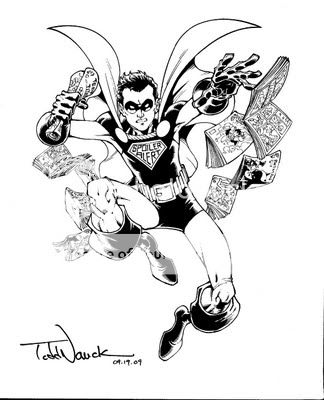
* Renee French is freaking me out.

* He-Man is awesome. (Via Kiel Phegley.)

Some kind of monster
October 26, 2009Kathryn Bigelow’s The Hurt Locker starts off by playing upon what I believe is the oldest and most primal human fear, developmentally speaking. You sit down in the theater with its stereo surround sound blazing, you watch a team of explosive experts use an all-too-clumsy robot to gingerly manipulate a roadside bomb in Iraq, and before you know it your heart is pounding because an explosion could occur at any moment and some part of your brain really, really does not want to be startled by a loud noise.
The whole rest of the film is essentially a demonstration of how life as a soldier (or civilian) in Iraq works in much the same fashion. Though far from the comfy confines of a movie theater on 13th Street, these people are similarly subjected to an environment where something brain-rattlingly terrifying could happen to them at any moment. Most of the film’s set pieces–and it basically moves from set piece to set piece, like Saving Private Ryan (with one key difference I’ll get to in a moment)–create tension and suspense simply by demonstrating, through a few shots of a byzantine network of alleys or featureless expanse of desert or cramped and hole-riddled warren of rooms, that there is literally no possible way that our trio of American soldiers could prepare themselves for every way in which that brain-rattlingly terrifying thing could happen. Keep your eyes in one direction and get shot from another. Defuse a bomb and get blown up by the one five feet away from it. Pop your head up to shoot someone and get shot in return. And unlike in Spielberg’s paradigm-shifting shakicam action epic, there’s no sense of forward momentum, no inexorable drive to the fulfillment of a quest. There’s just a countdown till the last day in Bravo Company’s rotation, a slow grind of hundreds of daily life-and-death situations, an increasingly indistinct and almost pointless parade of triumphs and tragedies. A tedium of terror. To the extent that the film has an ideological or political component, you can suss it out from there.
But it’s a very big world with a lot of people in it, and surely there are people out there who don’t just survive such a situation but thrive in it. That’s Sgt. James, our hero, played by Jeremy Renner just as marvelously as anyone who’s seen Dahmer or 28 Weeks Later would expect. Like Sanborn and Eldridge, the two other men in his three-man bomb squad, I spent much of the movie trying to figure out what makes this guy tick. Is he an arrogant, cigarette-smoking John Wayne wannabe, living every day as if this is the one during which he can walk away from an explosion in slow motion? Is he Robert Duvall in Apocalypse Now, a bloody-handed sociopath glibly waltzing through the killing fields, knowing that some day this war’s gonna end but never quite allowing himself to finish the thought? Is he enacting some sort of slow-motion suicide by haji, running headlong away from responsibility for others and for himself alike until someone or something finally puts him out of his misery? Or is he just the best damn explosives expert anyone’s ever seen–as Eldridge puts it, “not very good with people, but a hell of a warrior”? In one brilliant scene, a murderous commanding officer follows up a near-disaster outside the UN compound with a creepily complimentary inquisition of James that seems to entertain all these possibilities at once.
Two key conversations convey one last possibility: that there’s no real method to James’s madness. We can rule out sociopathy, at least, because he clearly cares deeply about some of the violence’s victims–though his pathos in this regard turns out to be both dubiously inspired and stupidly, self-aggrandizingly addressed. But beyond that, how can he do it? I don’t know, I don’t know, I don’t know, he says; later, he casts life as a process by which the things you love are slowly revealed to be basically garbage, except for one or two real, true things. It’s love as a fix, and his love, his fix, is his pas de deux with death. He seemingly can’t help being the way he is any more than Bodie from Bigelow’s Point Break (or Johnny from Mike Leigh’s Naked, whom I thought of quite a bit by the end). In this light what looked like recklesness, like not caring, is revealed to be what he cares about the most. His body needs a blast radius.
Carnival of souls
October 26, 2009* Today on the Con War front: I’m pretty happy with how my Robot 6 piece on the friendly date-switch deal made by Heroes Con and Supercon came out. There are the usual Wizard/Reed tidbits mixed in there as well.
* I also enjoyed the lengthy round-up by Heidi MacDonald and Tom Spurgeon’s “what does it all mean, and not mean?” piece. Tom makes one really interesting distinction, between “aesthetically gross” stuff done by the various cons and “ethically gross” stuff, which is a different and more pressing issue but which remains difficult to separate from the former category simply because so few people are willing to go on the record about the many, many shady things being whispered about behind the scenes.
* Robot 6 is rebranding itself Robot 666 for this pre-Halloween week. Boo!
* Paranormal Activity beat the tar out of Saw VI at the box office during the latter’s opening weekend. To me this isn’t a story of David and Goliath so much as Goliath in David’s clothing vs. Goliath’s great-great-great-great-grandson, but hey, worth noting.
* It’s a great privilege to be able to claim Jim Hanley’s Universe as my Local Comic Shop. It’s with that in mind that I read and appreciated Jim Hanley’s eulogy for his late buisness partner Rich Hafstead. (Via Dirk Deppey.)
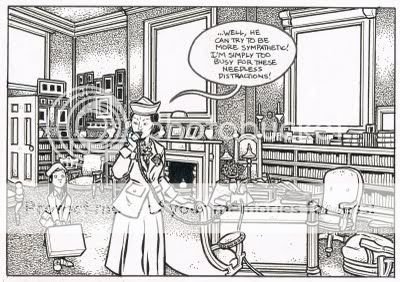
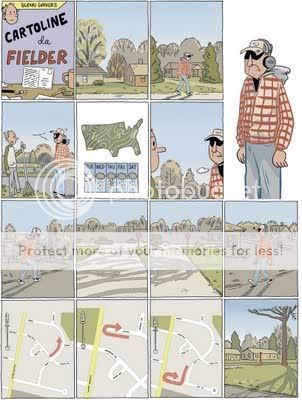
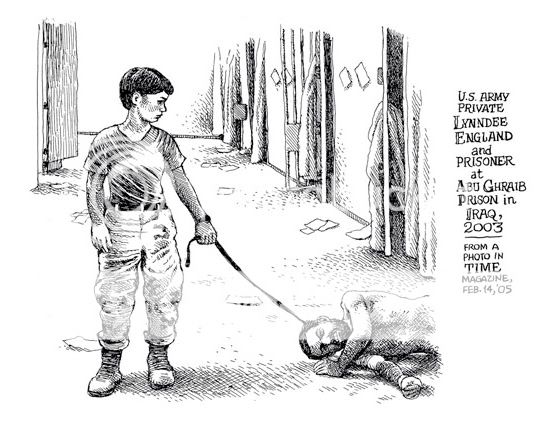
* Old Al Columbia! And new Al Columbia I had no idea existed!
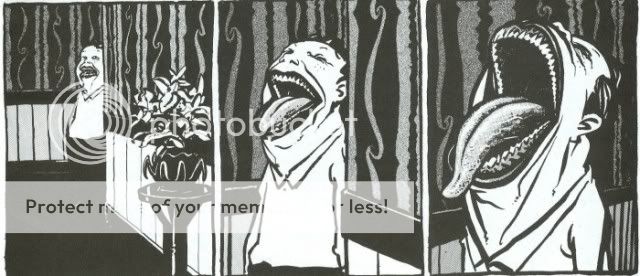
* I dig Frank Santoro’s minimalist APE recap. The Troublemakers is out!
* Real-Life Horror: 15 minutes of sensory deprivation can make you hallucinate. Via Andrew Sullivan, who points out that the United States government has subjected its own citizens to way, way, way more than 15 minutes of sensory deprivation.
* I loved The A-Team as a kid, and while I think the movie version will have a really really tiny needle to thread in terms of finding a tone that’ll make it enjoyable, I am indeed delighted by this picture of the cast. That’s Liam Neeson, believe it or not.
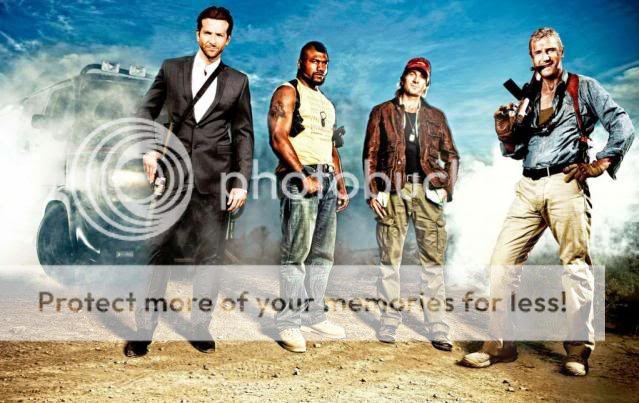
Comics Time: nothin’
October 26, 2009Today’s Comics Time review has been canceled because I accidentally read and reviewed a book that’s embargoed until Wednesday. I am a doofus. Comics Time will resume on Wednesday, and I may throw in an extra review at some point this week just to make up for this. You never know.
Comics Time: Invincible Iron Man #19
October 23, 2009
Invincible Iron Man #19
Matt Fraction, writer
Salvador Larroca, artist
Marvel, October 2009
40 pages
$3.99
It’s been a long time since I read superhero comic that wasn’t by Grant Morrison more than once out of enthusiasm rather than confusion. But golly, I enjoyed this one, and I enjoyed it just as much the second time around.
Subtitled (somewhat pretentiously) “Into the White (Einstein on the Beach),” this is the conclusion of the year-long “World’s Most Wanted” arc of Fraction and Larroca’s movie-toned Iron Man book, in which the disgraced and deposed Tony Stark runs around the world trying to destroy both his tech and his own mind lest both fall into the hands of new King Shit of Turd Mountain Norman Osborn. In the past I’ve found this set-up very hard to swallow because of how dependent it is on other, lesser comics like Civil War and Secret Invasion. For example, I don’t care what universe you live in, if Bernard Kerik can go from Homeland Security chief nominee to getting his mugshot taken, it strains credulity that a guy who used to dress up as a goblin and throw pumpkin bombs at people is gonna get put in charge of jack shit.
But Fraction compensates for this inherited conceptual sloppiness simply by making the plot mechanics for this story as tight as he possibly can. He cuts relentlessly back and forth between the protagonists and antagonists: the Charlie’s Angels trio of Black Widow, Maria Hill, and Pepper Potts attempting to escape from Osborn’s lair; Osborn’s second-in-command Victoria Hand trying to prevent this and quaking in terror of what will happen if she doesn’t; Osborn himself cockily closing in on his quarry; the intelligence-officer grunt who’s secretly feeding Osborn bad information and the colleague who smells something fishy about him; and Iron Man himself, experiencing an Algernon-like loss of his faculties as he hurls himself in his dilapidated old armor toward his final destination. If you’ve ever tried to write an action sequence, let alone cross-cut between several of them, you know how hard it is to get what needs to happen to happen for any reason other than your need for it to happen, right? Well, never once do the A-B-C sequencings of Fraction’s various plots feel like they’ve skipped a letter just to get to point Z quicker. From the captured spies moving up and down and in an out of an elevator, to the precise interpersonal dynamics between all the personnel involved in Norman’s pursuit of Tony Stark, each moment proceeds directly from the last, whether physically or emotionally.
How many fight scenes have you read lately where a character will get smacked several dozen yards by some giant powerhouse only to be up and about a few pages later? How many times have creators had to go online to clarify the physical fate of a character whose beating they wrote into incomprehensibility? How many times has a climactic battle been undercut completely by glib banter, almost completely disconnected from the circumstances of that place, that moment, those characters? You’re not gonna get any of that shit here. Each scene and sequence feels like it’s taking place in a physical space you and the characters could navigate, with physical maneuvers having readily understandable physical consequences. Each move toward and away from the characters’ goals comes with a sense of the stakes involved–the grand illusion of serialized shared-universe superhero storytelling, that there really can be winners and losers, has rarely been so astutely conveyed.
This is all the result of what feels like a real partnership. This issue’s success is equally due to Fraction’s just-right dialogue and direction and Larroca’s deft work with body language and fight choreography. (His days as a Greg Land-style spot-the-photoref novelty act are loooooong behind him.) Both shine brightest in the climax, making Osborn’s slide from glee to rage to frustration to confusion to defeat snatched from the jaws of victory as clear as day and almost frightening. It’s capped off with a one-liner in which the totality of Tony’s pwnage of Norma is made hilariously clear (provided you’re a Marvel nerd), and a one-page coda that manages to set up the coming mega-crossover without losing a sense of beatific victory and loss.
Did I mention that they managed to rehabilitate Iron Man’s badly damaged character in my head, despite the fact that even now none of his actions during Civil War have turned out to make any kind of practical or moral sense within the world of the story in any way? And that they managed to establish Spider-Man villain the Green Goblin as a for-the-ages Iron Man enemy as surely as Frank Miller made Kingpin the archnemesis for Daredevil? I dunno, man, this is some mightily effective work in this genre. I feel like it should be taken apart and studied at story summits for a long, long time: If this is what you want to do, this is how you want to do it. Aw, hell, I’m gonna read it again.
Carnival of souls
October 23, 2009* Today’s Strange Tales Spotlight: Jonathan Jay Lee. You might not have heard of him before–I hadn’t–but his work sure looks lovely.
* Beware the savage lure of Matt Wiegle’s 1984.
* Get this: Two Kentucky librarians refused to allow an 11-year-old to check out The League of Extraordinary Gentlemen because they thought it was “pornography”…and they got fired for it! Regardless of the wisdom of letting your 11-year-old read Alan Moore’s Mina Murray/Allan Quartermain May-December fanfic, you have to admit it’s delightful to see the kinds of nitwits who’d label this book “pornographic” get shitcanned for it.
* I’m not reading this until I see the movie, and god only knows when that will be (The Hurt Locker, A Serious Man, Zombieland, etc.), but for what it’s worth, the estimable Rich Juzwiak has titled his review of Paranormal Activity “Believe the hype”.
* I read Devin Friedman’s GQ profile of Von Dutch/Ed Hardy mastermind Christian Audigier in the pharmacy yesterday and realized that if you combine it with The New Yorker‘s James Cameron profile and Bronson Pinchot’s (ongoing!) tell-all interview(s), you get a sort of group portrait of contemporary Hollywood awfulness. (Pinchot link via Whitney Matheson.)
Carnival of souls
October 22, 2009* Over at Robot 6, I pointed out the Frank Miller/Victor Davis Hanson connection (via Rodrigo Baeza), linked to the Kramers Ergot 7 minicomic (via Blaise Larmee), and continued riding the Con War train into Pulitzer Junction.
* Today, my Marvel.com Strange Tales Spotlight shines on Jay Stephens.
* And eff it, I’m linking to my interview with Brian Chippendale for Providence’s website one more time. If n’ Oof is going to be 700 pages long, did you know that?
* TJ Dietsch’s list of The 12 Weirdest Horror Movie Theme Songs at Topless Robot is solid gold. I figured nothing would top Burt Bacharach’s “Beware of the Blob,” but then I didn’t count on “The Ballad of Harry Warden.”
* Kristin Thompson presents Hollywood blockbusters: weapon against the trade deficit!
* Real-World Horror: A group of prominent pop and rock musicians have joined together to demand that their music stopped being used to torment prisoners at Guantanamo Bay. No one saw the irony of using “March of the Pigs” to torture people?
* Wow, that really is a great Nova sketch.
* Finally:
Its a wild world. You can travel to the US city of your choice with your cowboy hat and your stirrups and have a gun fight in a back alley. You can sign up with Blackwater Inc and go murder woman and children in Iraq and get good health benefits as well. Grab a job at the Pentagon or a private firm piloting robotic drone bombers in Afghanistan, 10 points for a grandma! 20 for a pregnant lady! You might even hit a Terrorist! Air conditioned office, ergonomic chairs, free coffee! Hell, sign up to print those huge signs that folks with lots of extra time and solid legs hold outside of family planning clinics, photos of bloody, melted, gnarled, oozing aborted fetuses. Drive home after a long hard day of life-saving life-affirming work to eat a good rare steak, dripping red juice. Beat your kid. Feed the dog. Swing by the church to check out the choir boys. You can sleep under a bridge with homeless families near a halted condo development, or you can peep under a different bridge to see a sanctioned village of sex offenders, each with a scarlett letter stamped on their forehead. You can pray in a circle of your friends around your sick daughter as she dies of treatable diabetes, a display of failed Magic/Kung Fu. You can listen to radio hate-seller Rush Limbaugh spew violence that we can only hope will turn inward on his vacant icy soul, causing a massive, prolonged, agonizing heart attack. His already bloated body writhing in an unseen torture, as his inner demons “blow off some steam”. He can broadcast the grunts, the groans. I will turn on my receiver, I will amplify his final address, the hospital gets caught up in paperwork but he will live on in some fashion.
And that, ladies and gentlemen, is how Brian Chippendale begins his review of The Hands of Shang-Chi, Master of Kung Fu #34.
Gossip Girl thoughts
October 21, 2009* Blair’s All About Eve dream sequence marked the Gossip Girl debut of Vanessa’s cleavage. Let’s hope it’s a recurring role!
* Not to be outdone, Chuck makes his first appearance in a purple paisley bathrobe. For those keeping score at home, Prince is now the second-coolest man to (presumably) have worn this garment. And Chuck is two-for-two for sleepwear this season.
* I was pretty impressed with the poker storyline. Clearly they’re going to keep the “schemes” portion of the show as larger-than-life as Chuck and Blair’s earlier anti-Carter machinations would indicate. Betting for a man’s life is about as big as it gets.
* Blair listed Mao as one of the philosophers she wanted referenced in her speech? Alert Glenn Beck!
* Despite getting off to an auspicious start, Vanessa was really loathsome in this episode. That was some bush-league psych-out stuff from her regarding Olivia, Dan, and the speech. With each scene she dug herself deeper, fucked over her supposed best friend for no reason even worse, and made me hate her more. And it wasn’t just her that was annoying, it was the whole mix-up storyline, which is the sort of thing I almost physically can’t stand. Cleavage pass revoked, Vanessa.
* And here’s the funny thing: The kind of behavior that makes you hate Vanessa makes you love Blair. “You really think you’re that much better than me?” “Oh, I think we both know the answer to that?” We sure do, Blair!
* She was so horrible that I kind of enjoyed that her mom was even more insufferable than she was, to the extent that it made her life worse. Mom walking in to hear Vanessa declare how much she hates her was just icing on the schadenfreude cake.
*Related: By all means, Gossip Girl writers, lay shit like “He’s installing the solar panels on the chicken coop at the co-op” as thick as you please. In the Gossip Girl world, that is of course the only lens through which progressivism could possibly be seen.
* That said, Vanessa’s instantaneous reaction to her mom blowing her off at the coffee place was beautifully acted by Jessica Szohr, and actually moving. The Missus and I just turned and looked at each other and made sad faces, which is saying something given that we’d spent the whole episode hoping they’d kill her off.
* Okay, okay. I know what you’re really here for. And yes, the Chuck-on-dude kiss was a cop-out. (I wanted tongue, goddammit.) But here’s the thing: The lead-in and follow-up were sooooooooooooo magnificent that I couldn’t stay mad if I tried. Chuck’s affirmative smile and nod when Blair revealed the target was a guy and asked him if he was still up for it…”Can I help you?” “Oh, definitely.”…”You think I’ve never kissed a guy before?” Hoyay to the UNNNNNNNNF power. Chate shippers, there’s still hope!
Carnival of souls
October 21, 2009* At Robot 6, I continue to be the Ben Urich of the Con War.
* Is the $3.99 price point on certain Marvel and DC comics hurting post-launch sales? I’d add two other questions: Does Marvel’s method of raising the price on its “important” books cannibalize mid-list sales? And does DC’s method of adding back-ups starring B-list characters to justify its price increases move the needle one way or the other?
* This week’s “best of the horror blogs” round-up at The League of Tana Tea Drinkers focuses on bloggers’ favorite horror novels. I’ve got a couple links in there for the curious.
* Every interview should be like The Onion AV Club’s Bronson Pinchot interview.
Comics Time: Slow Storm
October 21, 2009
Slow Storm
Danica Novgorodoff, writer/artist
First Second, 2008
176 pages
$17.95
This is like half of a good book. The visual half, for the most part. Danica Novgorodoff’s story of a Kentucky firefighter and the undocumented Mexican worker she kinda sorta befriends after a fire claims the stable he tended is a stunning-looking thing. She has a wiry line that often suggests handwriting, with all its idiosyncracies, so that the occasional wonky scale or perspective seems like (or can be passed off as) a deliberate choice. Individual moments beam out a little Taiyo Matsumoto, a little Ralph Steadman, a little Gerald Scarfe, only with the dial turned from savage to lilting. And her watercolor coloring takes a limited palette of greens, browns, grays, and oranges and fleshes out the artwork so lushly I barely even realized just how few colors she limited herself to in the first place. It’s in the moments where she really draws with the colors–a creek, a tornado, the omnipresent cloud and fire motifs–that the book comes alive.
But its in moments where the dialogue takes the lead where it sputters. Frequently too portentous–every conversation creaks under the weight of capital-M Meaning–it fails to convince us of firefighter Ursa’s shattered psyche, so that when she perform’s the book’s central act it feels like a horrifying, selfish overreaction. Which, granted, it’s supposed to feel like, but you’re also supposed to think “okay, I could see where that came from,” whereas I just thought “Christ, what a fucking maniac.” Ditto her behavior during the event’s fallout, which adds “asshole” to the equation. Meanwhile, Rafi, the Mexican immigrant, is laden with poetic visions of saints and white horses–it’s just laid on too thick. The key for Novgorodoff (an Isotope winner and Eisner nominee who clearly doesn’t need any advice from me but what the hey) will be to scale back her swing as a writer and tell a story as understated as her art is sweeping.
Carnival of souls
October 20, 2009* Perhaps the best way to describe Dana Goodyear’s instant-classic New Yorker profile of James Cameron–and describing it doesn’t do it justice at all; you simply must read it–is to say that after reading it, you’d find suggestions that the rig in which Cameron sits in the picture below is either a movie prop, his directing rig, his personal mode of transportation, or a throne upon which he insists on sitting during meetings with studio executives all equally plausible.

* Not as long, and more intro-level, but almost as interesting, is Brian Rafferty’s Wired profile of Tim Heidecker and Eric Wareheim of Tim & Eric Awesome Show, Great Job! I’ve talked about maybe writing something lengthy about Tim & Eric around here in the past, but I’m frankly daunted. I don’t think they’re done having whatever effect it is they’re having on how I look at art yet; I get the hunch it could be eventually be measured on the same scale as my discovery of Velvet Goldmine and David Bowie in late 2000. The Missus and I compare them to Monty Python and mean it.
* Tom Spurgeon’s right: It is fun to yell “Con War.” I like to do it in the voice of Jack White doing his “Conquest” cover. Anyway, Spurge interviews NYCC’s Lance Fensterman, as does Kiel Phegley, about the now open hostilities between Reed Exhibitions and Gareb Shamus Entertainment. Fensterman points out something I’d missed, which is that Shamus’s Toronto show isn’t just a rival to Fan Expo, but to the Reed co-sponsored Penny Arcade Expo East, directly against which Shamus scheduled the Tornoto show; he says they saw this particular move coming in that light. And to Spurge’s credit, he explicitly asks Fensterman about alleged Shamus/Wizard misconduct, reports/rumors of which have been circulating off the record for several months now. Fensterman doesn’t take things much further than that, though he asserts that Wizard inflates its attendance numbers in his interivew with Kiel. I wonder who will be the first to talk on the record about some of the other allegations making the rounds.
* Meanwhile, Heidi MacDonald’s photo parade proves that sometimes a picture really is worth a thousand words:

* Over at Robot 6 I put in my two cents on Sandy Bilus’s 100 Best Comics of 2008 meta-list, an excellent mathematically derived list that rose phoenix-like from the ashes of the late great Dick Hyacinth. Sandy chimes in in the comment thread with some interesting info about the list’s Number One, so do check it out.
* Dude. Dude. Dan Nadel writes about Happy Hooligan. Look at it, dude. They face the audience. They face the audience! What a motherfucking eureka moment this is for me, I really can’t even begin to tell you. They face the goddamn audience!!!
* At first it seems like David Allison’s piece on Inglourious Basterds and Hitler riffing is out to hoist me by my own petard, but that’s mostly a headfake to illustrate how what Quentin Tarantino is up to in his movie is quite different from revisionist trivializing.
* Is this the perfect Monster Brains post? MB’s Aeron Alfrey digs up a Fangoria reader-participation “design the alien for John Carpenter’s upcoming remake of The Thing art contest from 1981. Pure delight.

How does this keep happening?
October 20, 2009
Draw a line in the sand, comics. Draw a line in the sand. (Via Heidi Mac.)
Sometimes I despair
October 20, 2009Sometimes Victor Davis Hanson despairs, too, mostly over the surfeit of homos and hip-hop and liberals and such sullying the beautiful pop-culture of our grandparents. But fortunately, sometimes Frank Miller shows up in his comment thread to cheer him up. Does that “he is the hero” Chandler quote get invoked? You bet your ass it does.
Utterly amazing. (via)
Comics Time: Driven by Lemons
October 19, 2009
Driven by Lemons
Joshua W. Cotter, writer/artist
AdHouse, September 2009
104 pages, hardcover
$19.95
Buy it from AdHouse, eventually
So yeah, this is pretty much the ideal Josh Cotter comic for me. Didja like the bizarre, symbol-laden wordless reveries of Skyscrapers of the Midwest? Here’s a whole book full of them! This shit makes the locust/migraine sequence from Skyscrapers #2 look like Dilbert! What’s it about? In large part, who cares? Like (in my experience) most great comics, it’s about how, and what, it makes you feel. It makes me feel like one of those ’80s special-effects sequence where some being’s exterior shell is chipping away and beneath each chunk that falls off a blindingly bright white light shines out like a beam–like that’s basically what Cotter did to his own brain to produce this thing, and like that’s what you run the risk of if you stare too long.
That’s essentially what Cotter does, visually, over and over again throughout the book: Something will cause one of Cotter’s nominal protagonists (anthropomorphized Life in Hell bunnies, pretty much) to spew forth from his person an amount of visual information that totally overwhelms them and the page itself, scribbled and scribed like a Charles Crumb notebook, and at one memorable point caked/painted with watercolors squeezed straight from the tube. In that light, and considering the first section’s apparent Chicago setting and slow evolution into comics from a straightforward-ish stream-of-consciousness prose-plus-doodles diary format, it’s tempting to read the book as some sort of autobiography: a story of the onset of, treatment of, and recovery from mental illness. For what it’s worth, I interviewed Cotter about his life and work at length for The Comics Journal and such an incident never came up, though I could have just whiffed on it. If I’m wrong, so much the better for Cotter, because having dealt with the mental-health institutionalization of two people very very close to me, this is about as accurate a representation of what I always pictured going on in their heads as you’re gonna find. Noise, blotting out signals and forming its own.
Glorious noise, too. For all of the books insular inscrutability, several passages here stand out with an effect as awe-inspiring as a great visual effects sequence in a blockbuster by some genuine Hollywood visionary. The paint explosion. The great cloud of scribble, with sensuously tangled lines looking like they’ve somehow been carved through other lines. The marvelously reproduced, bright reds and blues representing warring states of mind, popping off the off-white pages like 3-D. (The whole book, a facsimile of Cotter’s sketchbook, is really an astonishing work of design by Cotter and Chris Pitzer.) The forward momentum of the chase sequence, with two bunnies battling for supremacy in frame after Haring/Muybridge mash-up frame. An eruption of a column of red that rockets into the sky so powerfully you can practically hear the noise. And a creepy cameo by the mad god Dionysus, quoting the soundtrack from the animated Transformers movie, rings out as a reminder of madness after all is said and done like that dissonant shot of the cab’s rear view mirror at the end of Taxi Driver.
Outstanding work. Where the hell does he go from here?
Carnival of souls: Special “Carnival of Sean” edition
October 19, 2009* I’m pretty happy with this interview I did with Brian Chippendale for Providence’s arts/tourism website. What a fascinating guy.
* My Strange Tales Spotlight interview with Stan Sakai was a lot of fun, too. Samurai Hulk!
* I’ve been keeping pretty busy at Robot 6 now that the post-Anaheim/C2E2 “phony war” phase of the Reed/Shamus conflict is over and the Blitz has begun. Here’s my latest Con War report, featuring reactions to the now-completed Big Apple Comic Con over the weekend. Earlier reports are here and here.
* Elsewhere at Robot 6, I wrote an obituary for the late George Tuska, gave shoutouts to Vice’s Where the Wild Things are comics gallery and Marc Silvestri & Whilce Portacio’s Filipino flood relief charity auction, and revealed what I’ve been reading.
* And I can’t find it on Marvel.com yet, but the latest episode of What The–?! is up. What do you mean, “to play us out”?
* Jeet Heer calls for the creation of a “proto-graphic novel” master list. Seriously, it really would be nice to gather all such titles all in one place. I’d love to see “graphic novel” be fairly generously defined in such a list, too, because the purpose should be comprehensiveness rather than orthodoxy. In other words, Milt Gross and “The Monster Society of Evil”–come one, come all!
* I love the idea that I am in some way responsible for making Kiel Phegley appreciate He-Man and the Masters of the Universe. I also love Poe Ghostal’s list of five incredibly obscure MotU characters he’d like to see made into toys for the first time, which I found courtesy of Kiel.
* Check out Rickey Purdin’s Big Apple haul. I really can’t get over getting Acme #19 for four measly American dollars.
* CRwM’s epic game-theory march through the Saw franchise continues. Brilliant.
* Ceri B. walks us through the lair of the silithids, a sentient insectoid race wreaking Lovecraftian havoc in World of Warcraft. The still-twitching limbs of a long-dead beast so big it could pass for a geographical feature are a marvelously disgusting touch.
* What have we here, Kevin Huizenga?
*Renee French. Jiminy Christmas.

Before everyone gets all Rich Johnston breathless about this
October 17, 2009I know the last time this happened this was a bizarrely controversial point to make, but can we please agree this time around that if your convention gets closed down by the fire marshal, it’s not a sign of success, it’s a sign that you should have planned your convention better?
Comics Time: Abstract Comics
October 16, 2009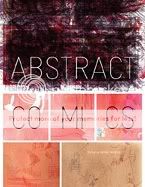
Abstract Comics
Andrei Molotiu, editor
R. Crumb, Victor Moscoso, Spyros Horemis, Jeff Zenick, Bill Shutt, Patrick McDonnell, Mark Badger, Benoit Joly, Bill Boichel, Gary Panter, Damien Jay, Ibn al Rabin, Lewis Trondheim, Andy Bleck, Mark Staff Brandl, Andrei Molotiu, Anders Pearson, Derik Badman, Grant Thomas, Casey Camp, Henrik Rehr, James Kochalka, John Hankiewciz, Mike Gestiv, J.R. Williams, Blaise Larmee, Warren Craghead III, Janusz Jaworski, Richard Hahn, Geoff Grogan, Panayiotis Terzis, Mark Gonyea, Greg Shaw, Alexey Sokolin, Jason Overby, Bruno Schaub, Draw, Jason T. Miles, Elijah Brubaker, Noah Berlatsky, Tim Gaze, Troylloyd, Billy Mavreas, writers/artists
Fantagraphics, 2009
232 pages, hardcover
$39.99
Visit the Abstract Comics blog
One of the pleasures inherent in anthologies is the way proximity draws out the contrast between successful and unsuccessful work. One of the unique pleasures of this anthology is how that success or lack thereof can be determined not just by the subjective standards of the reader but also by the ostensibly objective standards of the anthology itself. In his introduction, editor Andrei Molotiu defines abstract comics thusly:
What does not fit under this definition are comics that tell straightforward stories in captions and speech balloons while abstracting their imagery either into vaguely human shapes, or even into triangles and squares. In such cases, the images are not different in kind, but only in degree, from the cartoony simplification of, say, Carl Barks’ ducks….While in painting the term [“abstract”] applies to the lack of represented objects in favor of an emphasis on form, we can say that in comics it additionally applies to the lack of a narrative excuse to string panels together, in favor of an increased emphasis on the formal elements of comics that, even in the absence of a (verbal) story, can create a feeling of sequential drive, the sheer rhythm of narrative, or the rise and fall of a story arc.
True, none of the comics featured here use (legible) captions or speech balloons. But as Molotiu’s subsequent emphasis on “images” implies, the lack of text is incidental to the more fundamental lack of narrative or story. It’s by that petard that several of the strips Molotiu selects are hoisted. The contributions from Ibn Al Rabin, Lewis Trondheim, Andy Bleck, and to an extent Mike Gestiv and Bill Shut all rely precisely the sort of “difference in degree” Molotiu warns about–in their comics, abstracted shapes perform actions based on recognizable, and in some cases quite clearly depicted, physical motivations and even emotions, just like the “triangles and squares” we’re told may as well be Uncle Scrooge. These strips are cute, but not exactly challenging, and far from abstract.
But the successful strips in Abstract Comics prove that comics need not depict emotions to pack an emotional wallop. Indeed, part of my long-held enthusiasm for this project stemmed from my suspicion, based on steps (small and giant alike) in the direction of abstraction during this decade by such alternative comics artists as Kevin Huizenga, John Hankiewicz, Anders Nilsen, Josh Cotter, and Frank Santoro, that abstract comics stripped completely away from their narrative moorings–abstract comics “in the wild,” as it were–had the potential to generate emotional content of enormous power. What I didn’t expect was just how…I don’t know, idiosyncratic my reaction to such comics would be.
For example, I’ve already described how the more openly narrative works contained here elicited a chuckle but not much else. What’s interesting to me is how the sorts of shapes used by those artists–outlined blobs, for the most part–left me cold even in purely abstracted form. The squiggles of Elijah Brubaker, the whorls of James Kochalka, suggest a warmth and an airiness I’m just not tuned into at all. I’m not a curve man, it turns out. Meanwhile, I’m equally unaffected by strips that eschew drawing sharp contrasts from image to image and panel to panel, either by muting the differences between juxtaposed visuals (Warren Craghead, Richard Hahn, Janusa Jaworski) or by weakening or eliminating the parametric framing and structure provided by panels (Noah Berlatsky, Billy Mavreas, Troylloyd, Tim Gaze, Bruno Schaub).
What I am interested in, it appears, are angles. boxes, cold geometry. Jason Overby’s “Apophenia” is perhaps my favorite comic in the whole book: Beginning with a grid of penciled-in panel borders containing nothing at all, it proceeds to flash various sharply carved shapes into panels at random intervals like sudden words emerging from a haze of silent static, or subliminal messages erupting from a blank screen. Mark Goneya’s “Squares in Squares” is just that, panel after panel of brightly colored squares surrounding one another like an infinite regression, their position within the panel shifting slightly to slow our eye’s descent into the abyss. Mutts creator Patrick McDonnell’s untitled, college-vintage contribution uses a repeated bisected-circle motif in black, white, and watercolor-blood red to suggest cold sunrises and magisterial eclipses. And Spyros Horemis black-and-white concentric circles and swirls practically glow off the page with the force of an optical illusion.
I’m also interested in a sense of awe and scale. Molotiu’s own excerpts from The Cave overwhelm with bright colors and massive slopes that dwarf panel borders and seem to escape his control, like a microscopic process blown up to IMAX size or a projected filmstrip set on fire. Henrik Rehr’s “The Storm” is as aptly named as was “Squares in Squares”: Great waves or windgusts toss us to and fro across black backgrounds, sending tiny offset panels scattering like leaves. Alexey Sokolin’s “Life, Interwoven” sees its panels slowly overwhelmed by furious black scribbling, like a diary of a madman, until it not only totally blots out the grid but appears to topple it over.
And sometimes I’m like John Cleese’s pope: I may not know art, but I know what I like. I like the loneliness of Blaise Larmee’s tiny, shaky, frail, incomplete rectangles against their off-white background in his Nilsenesque “I Would Like to Live There.” I like the humor of Geoff Grogan repeating a bullseye motif until the laugh-out-loud punchline photo of a woman’s nipple in “Bullseye.” I like Jason T. Miles creating shapes out of chunky, semi-monstrous black and white lattices–Brinkman Blocks, if you will–then signing it with a great big clumsy JASON T. MILES in “Mainstream Blackout.” I like the implied sequentiality of Mark Badger following up a pencil-sketched “Kung Fu” strip from 1980 with a boldly colored remake of the same strip from 2008. And I like the pure psychedelia–in the information-overload sense–in R. Crumb’s “Abstract Expressionist Ultra Super Modernistic Comics,” drawn, laid out, and even titled as though attempting to get it down on paper winded him.
So. By my count I liked, mmm, about half the book, give or take a couple strips. And there are potentially fruitful paths that remain largely untrodden. For example, I know Molotiu has been doing yeoman’s work on carving out a space for nonnarrative comics for years because I remember jostling with him a bit about on the Comics Journal messageboard following the release of Kramers Ergot 4 in 2003; however, the work of Fort Thunder and its fellow travelers, showcased so memorably in Sammy Harkham’s anthology, isn’t represented here (unless you count their spiritual godfather Gary Panter). Meanwhile, Crumb and Larry Zenick excepted, the use of representative figures in an abstract way is elided here; I wish Molotiu had selected one of John Hankiewicz’s enormously effective strips in this style rather than the comparatively staid and painterly contribution we see here. And for my money, the sequencing peters out toward the end–I’m not sure what I was supposed to take away from the final strips, rather formless black and white affairs. An editorial focus not so much tighter as tweaked, I suppose, is what I’m looking for.
But what I liked! What I liked, I liked for more than just the strips themselves–I liked them for the proof they offer that comics really is still a Wild West medium in which one’s bliss can be followed even beyond the boundaries of what many or even most readers would care to define as “comics.” That an entire deluxe hardcover collection of such comics now exists is, I think, one of the great triumphs for the medium in a decade full to bursting with them. And even if the book’s existence is ultimately more impressive than the sum total of its contents, it strikes me as churlish to complain.
